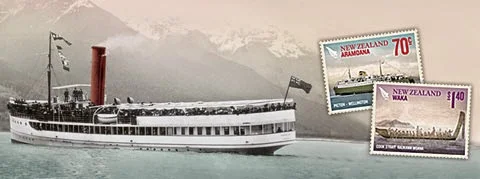As a small nation surrounded by water, New Zealand has relied on ships and vessels as a means of transport for as long as it's been inhabited. The 'Great Voyages of New Zealand' stamp issue features five vessels that have played a part in shaping New Zealand.
70c - Aramoana / Picton to Wellington.
The Aramoana’s big stern door transformed domestic transport in 1962. Prior to then, double-handling had made it too costly and slow for rail to compete with coastal ships, but roll-on, roll-off ships seamlessly connected the islands. In 2012 five such ships form a ‘floating bridge’. The 4,160-ton road/rail ferry Aramoana served until 1984.
$1.40 - Waka / Cook Strait to Raukawa Moana.
Over time Māori developed a range of distinctive dugout canoes ranging from the imposing waka taua (war canoes) to the humbler fishing canoes, river canoes and reed and flax craft. Usually paddled but sometimes assisted by mat sails, the bigger vessels could transport large quantities of people and trade goods across Cook Strait.
See Kupe and the First Maori Settlers.
For other stamps on Maori themes see our page New Zealand Maori.
See Kupe and the First Maori Settlers.
For other stamps on Maori themes see our page New Zealand Maori.
$1.90 - Earnslaw / Kingston, Queenstown and Glenorchy on Lake Wakatipu.
Tourists walk the triple - expansion steamer Earnslaw’s decks these days, but 100 years ago the ‘Lady of the Lake’ was a hard-working passenger, freight and livestock carrier, one of several linking the isolated farms and settlements of Lake Wakatipu. Designed and built in Dunedin and reassembled at the lakeside in 1912, the Earnslaw still burns coal today.
$2.40 - Dunedin / Port Chalmers to London.
In 1874 the Albion Line (later Shaw Savill & Albion) commissioned the 1,320-ton Dunedin for the immigrant trade, which it served until being converted in 1881 to carry frozen meat. A regular caller to Oamaru, the Dunedin vanished with all 35 crew after sailing from that port for London in March 1890; the ship probably hit an iceberg.
$2.90 - Rotomahana / New Zealand to Australia and Wellington to Lyttelton.
With its rakish bow, masts and funnel, the Rotomahana looked like an elegant steam yacht. The first ocean-going ship built of mild steel, the 15.5- knot ‘Greyhound of the Pacific’ spearheaded the Union Steam Ship Company’s grab for the trans-Tasman trade in the late 1870s. The 1,727-ton ship later served on the Wellington-Lyttelton and Melbourne-Hobart runs before being discarded in 1925.
Below are the four colour separations of this same stamp.
Below are the four colour separations of this same stamp.
Black. Cyan.
Magenta. Yellow.
This issue was produced using the printing process of lithography. The design was broken down into its four primary colours and printing plate (flat metal sheets) were made of these. The image on the plate is treated so it will except ink while the rest of the plate won't. This meant the stamp was printed using the four different colour images as can be seen above.
If you were to look very closely (which can't be done here) you would see the image is actually made up of thousands of tiny dots. As each colour is applied to the paper the four colour dots mix together and combine to create the illusion of the intended design. Try taking a magazine with lots of colour and look closely using a magnifying glass, you will be able to see these dots that make up the various images on the paper.
The First Day Cover & Miniature Sheet.
This is the official First Day Cover for this issue.
Notice all five stamps have been neatly attached over what appears to be an old map of New Zealand. They have been cancelled with two different cancels. The left one is in the form of a compass rose and the right one has two crossed paddles from a Maori waka (canoe).
This issue also had a miniature sheet, again featuring all five values.
Technical information:
Date of issue:
| 5 September 2012 |
|---|---|
Number of stamps:
| Five gummed stamps |
Stamps designed by:
| Creature, Wellington, New Zealand |
Denominations:
| 70c, $1.40, $1.90, $2.40 and $2.90 |
Printer and process:
| Southern Colour Print Ltd by offset lithography |
Number of colours:
| Four process colours |
Stamp size and format:
| 30mm x 40mm (horizontal) |
Paper type:
| Stamps: Tullis Russell 104gsm red phosphor gummed stamp paper. Miniature Sheet: Tullis Russell 104gsm non-phosphor gummed stamp paper |
Number of stamps per sheet:
| 25 |
Perforation gauge:
| 14 |
Some of the images in this post were used with permission from the illustrated catalogue of StampsNZ
You can visit their web site and On-line Catalogue at, http://stampsnz.com/












We appreciate your engagement with our content. To ensure a respectful and constructive community, please take note of the following:
- No Spam, Please: We do not tolerate spammy or promotional comments. Any such comments will be promptly removed.
- Moderation in Place: All comments are moderated to maintain a positive and inclusive environment. Please be patient, as it may take a little time for your comment to appear.
- Sign In with Google: To comment, please sign in using your Google account. This helps us maintain the integrity of our community and allows for better interaction.